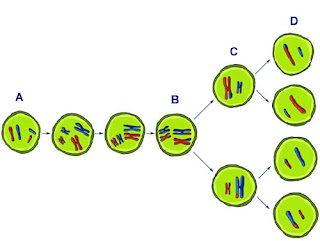 |
| Meiosis Diagram courtesy of sciencegeek.net |
One day, whilst
learning about how meiosis causes variation I had a brainwave. What if I could
cross my love of writing with my knowledge of meiosis? At first, I struggled to
think of the connections, but I think I’ve managed to work it out.
I will be using three
key ways that meiosis causes variation to think about how we, as writers, can
vary our writing. This article will form the final part in my three-part series
on being unique in writing.
Please note that I
have simplified the biology in this article and missed processes out to make it
more approachable for those without a scientific background.
Independent Assortment (of chromosomes on
the spindle)
In biological terms,
this means that chromosome pairs will align along thread (the spindle). This
means that it doesn’t matter where the other pairs go on the thread, each pair
will go wherever it pleases.
So, how can
writers apply this principle?
It doesn’t matter
what Stephen King is writing, or what Tolkien did – you are you. Put your
characters in the situations you want to put them in. Sure, the Lord of the
Rings is a successful series, but that doesn’t mean you need to copy it.
Be your own
writer. You know what you want to write better than anybody else does, and the
chances are somebody, somewhere will want to read what you have written. You
shouldn’t ignore other writers, but you should remember that the best writing
often comes when the author writes their piece in the way they wanted.
There is every
chance somebody will suggest a change to the plot and by all means embrace the
opportunity to make your piece more appealing, but if it goes against everything
your piece stands for … well, don’t do it.
Crossing-over
(of alleles)
In meiosis, the
crossing-over of alleles (a version of a gene) involves the formation of
chiasmata. Essentially, this means that one of the chromatids puts part of
itself over its sister chromatid and they swap bits. This then means that later
on there is variation between the originals and the new.
What does this
mean for writers?
This was partly
covered last month in Embrace the Cliché, but I will add to it now. It is fine
to use ideas from other authors when you mix them with your own. In the
long-run people will say, “this is a similar idea to…”, but they won’t be
saying, “this is the same idea as…”. The reason is that you crossed your ideas
with the other ideas making something unique.
There was a case a
while back with an author being found to have copied large chunks of Ian
Fleming’s James Bond series directly into his own writing. His defence was that
he was under stress to complete his work and he thought that the success of
James Bond would help him. What he should have done was taken a theme or idea
from a section of James Bond and mixed it with his own concepts. This would
allow him to embrace the success of James Bond without ripping it off.
Fusion of sex
cells (gametes)
Meiosis forms four
gametes. These cells will mature into sperm or egg cells for reproduction.
Remember how crossing-over of alleles created variation? Well, this is why that
is useful. Due to the sheer number of
unique gametes in both the male and the female, when two combine and fertilise
it causes yet more variation. The child produced from these two cells will have
features similar to both parents, but differences that make them unique.
How can a writer
use this concept?
By crossing-over
different ideas with their own from different sources, the end product will
have similarities to the original ideas, but still be unique in its own right.
This may sound
similar to the point I made above, but there is a subtle difference. I described
crossing over one concept with your own in the previous section, but here I am
describing the result of crossing many ideas over with many of your own.
Writing often
starts with very little and grows into a large, complicated baby for the
author. So, it seems apt that we can compare the process of writing to the
fusion of two tiny haploid cells fusing together and growing to produce a marvellous
and unique human being.
Hope this helps,
Matt B
No comments:
Post a Comment